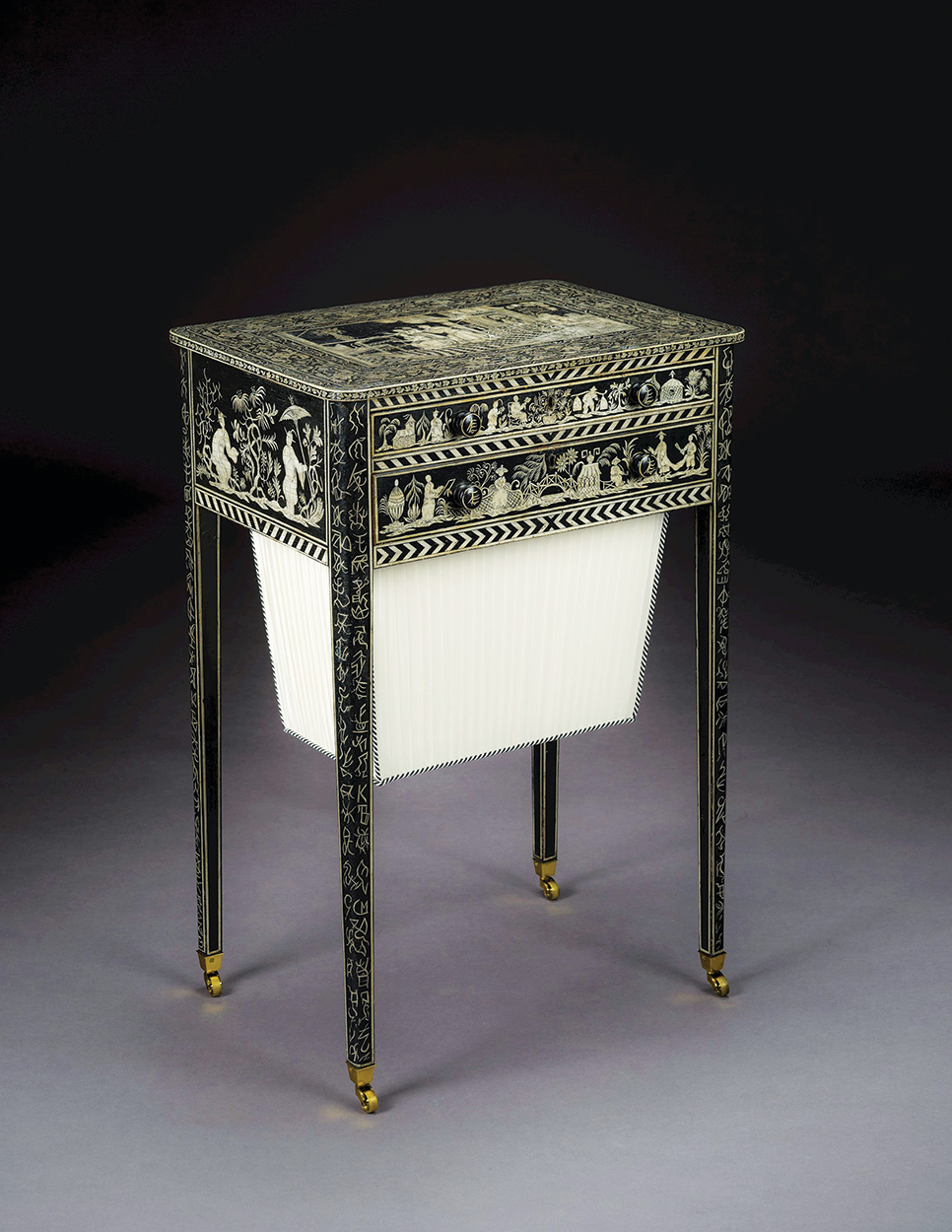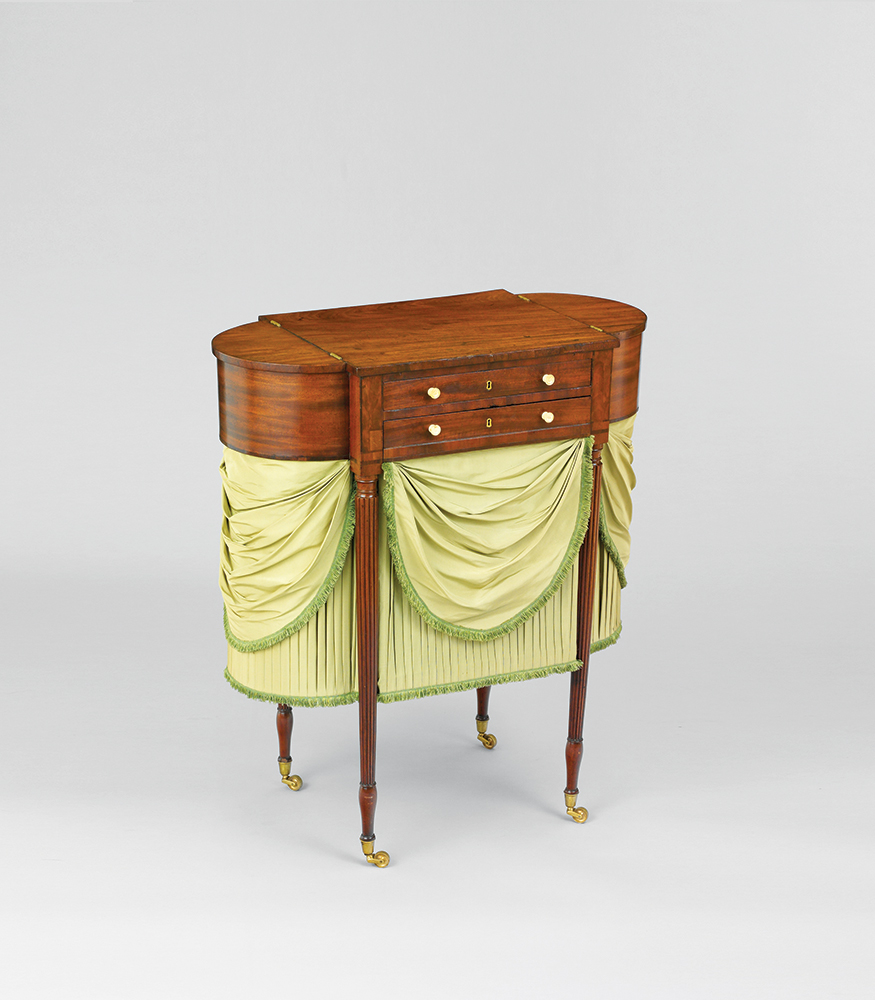A Woman’s Work-Table Is Never Done
Writer Leslie Gilbert Elman
Recently offered for sale, this sewing table, made in England around 1820, is decorated in the Asian-inspired fashion known as chinoiserie. It’s crafted from birch, cypress and mahogany that was “japanned” with multiple coats of black-tinted varnish or lacquer and covered with fine penwork decoration. A fabric-covered workbox extends from the bottom.
These multifunctional side tables have endured for generations
The progress of any nation in morals, civilization, and refinement is in proportion to the elevated or degraded position in which woman is placed in society,” says the introduction to The Ladies’ Work-Table Book, published in the 1850s by T.B. Peterson & Bros. of Philadelphia. “Every thing should be done to improve the taste, cultivate the understanding, and elevate the character of those ‘high priestesses’ of our domestic sanctuaries.”
Those words of wisdom might well have extended to the titular “ladies’ work-tables” themselves.
Conceived and designed to accommodate sewing and needlework, a lady’s work-table was a common furnishing in the parlor, library or living room of a 19th-century home. Decorative and lightweight, it could easily be moved from one position to another within a room or even from room to room. Its shallow drawers typically were divided into compartments for thread and notions and, in many cases, its most distinguishing feature was a hanging silk workbag or fabric-covered workbox to hold fabric, yarn or, as today’s crafters would call them, “UFOs—unfinished objects. Undoubtedly, there were times when that workbag contained ordinary clothing or linens for mending, but it was just as likely to hold decorative embroidery or knitting because even ordinary 19th-century women did needlework as a leisure activity and not only out of necessity.

A half-round flanked by flat planes, such as the ends of this lady’s work table, is known as an astragal shape. It was a favorite of cabinet-makers in the early 1800s, including Thomas Sheraton, whose patterns probably inspired this table. Made in New York sometime between 1805 and 1815, from mahogany, rosewood, Spanish cedar and other woods, it is now in the collection of the Metropolitan Museum of Art in New York City.
The famed English cabinet-maker Thomas Sheraton usually is credited with devising the so-called “pouch table,” fitted with a silk workbag in which the users would “deposit their fancy needlework.” Yet Sheraton’s 1803 Cabinets Dictionary shows an illustration of a pouch table made by fellow English furniture designer John McLean (or McLane or Macklane—he spelled it various ways), which tells us that other craftsmen produced the same sort of tables around the same time. In fact, it’s likely the pouch-style sewing table arose in England or France in the second half of the 18th century, and Sheraton coined the name for it sometime later.
Small as they are, the tables often served more than one function, with concealed writing surfaces, mirrors and/or game boards for chess or backgammon that pulled out, tilted up or could be otherwise revealed when needed. Along with his pouch design for a sewing table, Sheraton’s 1803 book included an unproduced design for a chess table with a game-board top and a fabric pouch to hold game pieces. With regard to materials, he specified, “The ground ought to be of black rosewood when [the tables] are required to be elegant, otherwise they may be made very neat of mahogany.”
Another English cabinet-maker, George Smith, who made furniture for King George IV, showed designs for a lady’s work-table and a backgammon table, both with hanging pouches, in his 1826 Cabinet-maker and Upholsterer’s Guide. Smith’s patterns were widely copied and adapted, with examples found as far away as New Zealand, where they were made of native woods such as puriri and totara.
Decorative styles varied with time, place and craftsman. The table that inspired this column is a stunning chinoiserie work-table made in England in the 1820s, recently offered for sale by New York City antiques dealer Hirschl & Adler Galleries. Mid-Atlantic cabinet-makers of the 19th century, including New York’s famed Duncan Phyfe, were fond of the so-called “astragal end” shape with half-round ends flanked by flat planes.
Sometimes the pouch swung out or pulled out from the body of the table; sometimes it was accessed through a bottomless lower drawer. A design from an 1853 Scottish cabinetmaker’s book has the pouch pulling out from the end of the table, “being in this way much more convenient for a lady’s use when sitting before the table.”
The ladies’ work-table form persisted right into the Edwardian era of the early 20th century. You’ll even find midcentury examples made in Scandinavia in the 1950s. And because so many were made in so many different styles over so many years, it’s possible to find one in good condition for sale at auction or by a reputable dealer at a modest price. While you might not use it to hold your own needlework-in-progress, as an accent piece, an antique ladies work-table has the potential to elevate the character of any room.
Leslie Gilbert Elman is the author of Weird But True: 200 Astounding, Outrageous and Totally Off the Wall Facts. She writes about antiques and other subjects for Design NJ.
